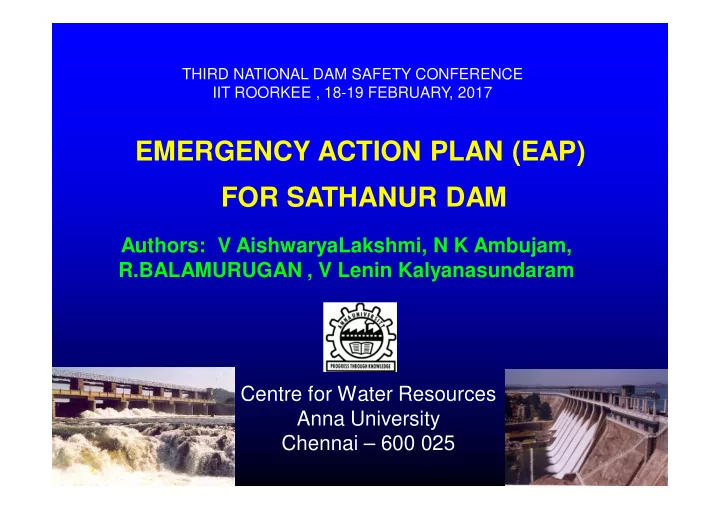

THIRD NATIONAL DAM SAFETY CONFERENCE IIT ROORKEE , 18-19 FEBRUARY, 2017 EMERGENCY ACTION PLAN (EAP) FOR SATHANUR DAM Authors: V AishwaryaLakshmi, N K Ambujam, R.BALAMURUGAN , V Lenin Kalyanasundaram Centre for Water Resources Anna University Chennai – 600 025
What is EAP? An Emergency Action Plan (EAP) is a formal document that identifies potential emergency conditions at a dam and specifies pre-planned actions to be followed to minimize property damage and loss of life.
EAP Document contains procedures and information to assist the PWD in issuing early warning and notification messages to responsible emergency management authorities, District Magistrate / Collector, Armed forces, Paramilitary forces, Project Authorities and other Central/ State Agencies. It also contains inundation maps to show the emergency management authorities of the critical areas for necessary relief and rescue actions in case of an emergency.
News alert through media
TAMIL NADU Index Map of Sathanur dam
SATHANUR DAM ADMINISTRATIVE MAP
DIGITAL ELEVATION PROCESS The development of a TIN model was one of the most essential steps in flood zone mapping and to produce a detailed flood plain HEC- Geo RAS PRE PROCESSING To create the geometry data, stream centreline, main stream banks and cross-section cut lines. It could import the GIS data to create the geometry file.
HEC-RAS MODELING The unsteady flow water surface profile’ is one of the component of HEC-RAS. The boundary condition requires flow hydrograph and initial condition requires initial flow. The HEC-RAS output was in the form in of water surface profile, cross section plots, cross sectional profile.
BOUNDARY CREATION DIGITL ELEVATION (TIN)
GEOMETRY CREATION
HEC- Geo RAS POST PROCESSING HEC-RAS post processing and RAS data imported to GIS. This will create a bounding polygon, which basically defines the analysis inundation mapping by connecting the endpoint of cut line. After the analysis extent are defined the inundation extent are found with the help of water surface generation option in RAS mapping. The HEC-Geo RAS pre and post processing resulted the flood inundation map.
Flood Q m 3 /s
FLOOD FREQUENCY TIME Peak Q (m 3 /s) PERIOD 10 3268.50 20 4466.75 50 6050.74 100 7248.98
FLOOD AFFECTED VILLAGES OVERLAY
FLOOD INUNDATION MAP ALONG WITH VILLAGE BONDARY
Total Number of Inundated Villages Number of Total inundated Number Number of Discharge in Number villages of inundated inundated Value of The YEAR in villages in villages in (Cumec) Villages Thiruvanna Villpuram Cuddalore Inundated malai 1972 7248.98 15 93 33 141 10 3268.50 15 78 27 120 20 4466.75 15 90 31 136 50 6050.74 15 92 32 139 100 7248.98 15 93 33 141
Economic Loss Details Economic Area of Area of land Depth Economic Loss land under Villages Major Crops under major of water Loss Rs/ For Major major crops crops in (m 2 ) level (m) (Ha) Crops In (Ha) Lakhs Paddy 70 700000 8.54 65,000 45 Kannakurukka Sugarcane 65 650000 8.54 80,000 52 Groundnut 40 400000 8.54 12,500 49 146 Paddy 65 650000 6 65,000 52 Olagalapadi Sugarcane 62 620000 6 80,000 56 Groundnut 50 500000 6 12,500 6 148 Paddy 55 550000 3.292 65,000 36.4 Edathanur Sugarcane 49 490000 3.292 80,000 37.6 Groundnut 40 400000 3.292 12,500 4.75 120 Paddy 60 600000 1.355 65,000 33 Allappanur Sugarcane 67 670000 1.355 80,000 53 Groundnut 35 350000 1.355 12,500 43 129
ECONOMIC LOSSES DUE TO INUNDATION IN AGRICULTURE LAND To carry out the estimate of economic loss, villages in Thirvannamalai district which are most likely to be inundated were chosen from the flood inundation map. . In Thirvannamalai district alone 15 numbers of villages are found to be inundation by this study.
Questionnaire survey The questions are related to economic impact data in all aspects like farmer’s details, land and crops details, flood details. The farmers are mainly cultivating paddy, sugarcane, groundnut and pulses. The entire agriculture land was submerged under flood events. If the total agriculture land was submerged there will be heavy loss faced by famers.
Sathanur command area – Tank and Irrigation details Water is released for irrigation from the Sathanur reservoir, from January 1st to march 31st. The water is released to SLBC and SRBC at the same time. Water is first let to Thirukkoilur Ayacut, followed by SLBC and SRBC. Sathanur Command area has 88 tanks. SLBC : 40 Tanks SRBC : 48 Tanks
The tank-irrigated areas are SLBC = 1139.948 Ha SRBC = 1781.18 Ha In the first season direct irrigation is done and later indirect irrigation CROPS CULTIVATION Paddy : 26.5% Sugarcane : 49.46% Groundnut : 8.42% Sunflower : 5.66% pulses : 1.9% Other crops : 8.06%
Outline of Questionaire Survey 1. Capital cost 3. Fertilizer and pesticide Nursery land preparation Manure and green manure Seeds NPK fertilizer Land preparation Pesticide and weedicide Land charge Water charge 2. Labour cost Seed showing & side cleaning Transplanting Manure and fertilizer application Weeding Harvesting
Economic Loss in Lakhs 10 20 30 40 50 60 0 Paddy Kannakurukka Sugarcane Groundnut Paddy Olagalapadi Sugarcane Groundnut Paddy Edathanur Sugarcane Groundnut Paddy Allappanur Sugarcane Groundnut
CONCLUSION This study focuses on the preparation on flood inundation map and identifying the vulnerable areas downstream of the Sathanur dam downstream upto Cuddalore. The HEC-RAS model was run to find the inundation depth for peak discharge 1972 event (100 year return period) the maximum depth of inundation found to be 11.723 m
CONCLUSION The output from HEC-RAS was overlaid on Google earth map to find out the inundated areas and the economic loss analysis was done in inundated through questionnaire survey. With the area of submergence the total amount invested by the farmers are lost due to the flood. For a 100 year return period it works to more than Rs. 50 lakhs. Flood inundation maps for different return flow are prepared. With real-time data early warning can be issused to protect the life and the property.
THANK YOU
Recommend
More recommend